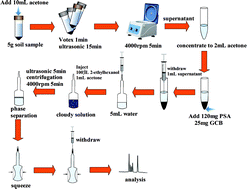A novel method based on combining ultrasonic-assisted dispersive solid-phase extraction and low-density solvent dispersive liquid–liquid microextraction (UA-DSPE-LDS-DLLME) for the determination of organophosphorus pesticides in soil
Abstract
A new method has been developed to determine trace levels of organophosphorus pesticides (OPPs) in soil samples by using dispersive solid-phase extraction (DSPE) combined with dispersive liquid–liquid microextraction (DLLME), followed by gas chromatography pulsed-flame photometric detection (GC-PFPD) analysis. In this approach, the OPPs were first extracted from the soil sample into acetone, and a DSPE purification step was performed using PSA and GCB as the sorbent material. Next, 1 mL of cleaned acetone (dispersive solvent-containing analytes) and 100 μL of 2-ethyl hexanol (extraction solvent) were rapidly injected into a 5 mL soft polyethylene Pasteur pipette containing 5 mL of doubly distilled water (aqueous phase), thus ending the pre-concentration step of the DLLME procedure. The upper solvent was collected and analysed by GC-PFPD after centrifugation. The advantage of the procedure was the use of a less toxic, low-density solvent and the use of a pipette as the extraction device. This method broadens the applicability of DLLME to a wider range of solvents. The ultrasound technique was applied to accelerate the emulsification and increase the extraction efficiency. Furthermore, the technique combining DSPE with DLLME not only pre-concentrates the analytes from environmental matrices, but also reduces the matrix effects. Additionally, the critical parameters affecting the extraction efficiency were systematically evaluated. Under optimum conditions, the proposed method was performed with good linearity in the range of 5 to 200 ng g−1 with a correlation coefficient between 0.9910 and 0.9967. The enrichment factors (EF) varied from 22- to 35-fold. The limit of detection (LOD) (S/N = 3) and the limit of quantification (LOQ) (S/N = 10) were 0.2–0.5 ng g−1 and 0.5–1.2 ng g−1, respectively. The relative recoveries at the two spiking levels of 10.0 and 50.0 ng g−1 were in the range of 79.6% to 106.8%, and the relative standard deviations (RSDs) were less than 8.0% (n = 5). The proposed method provides a sensitive, convenient, and eco-friendly process for determining OPPs in soil samples.


 Please wait while we load your content...
Please wait while we load your content...